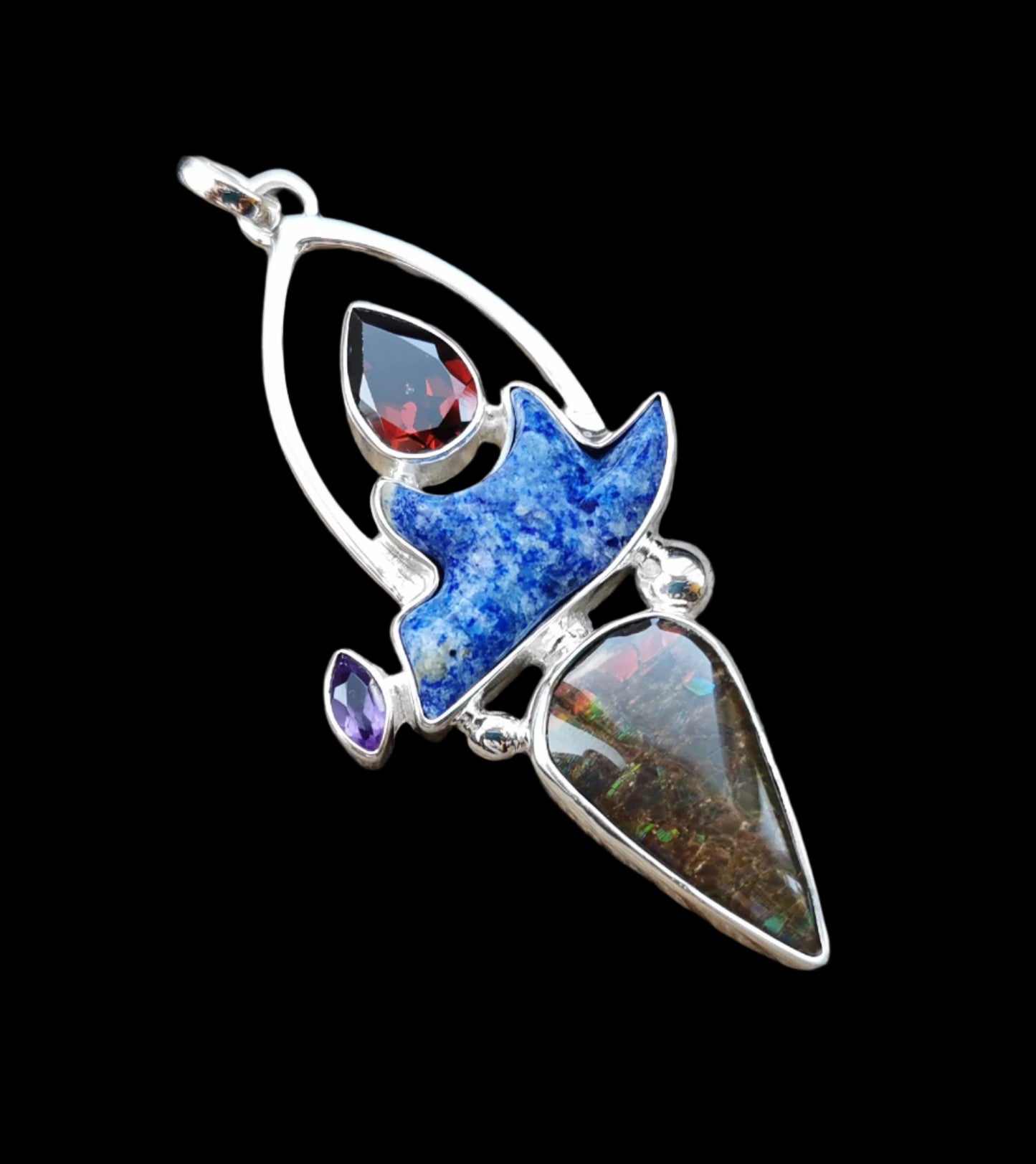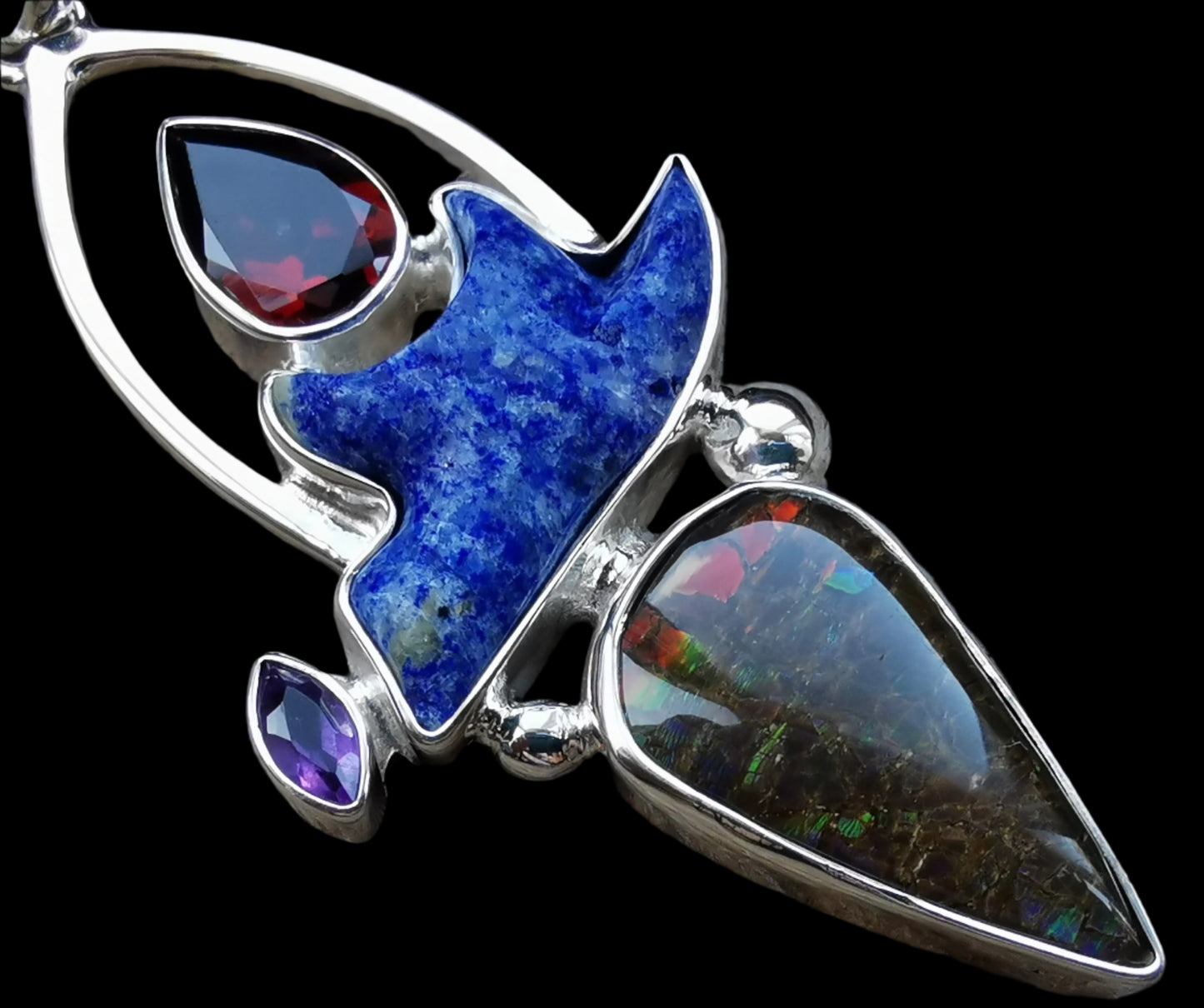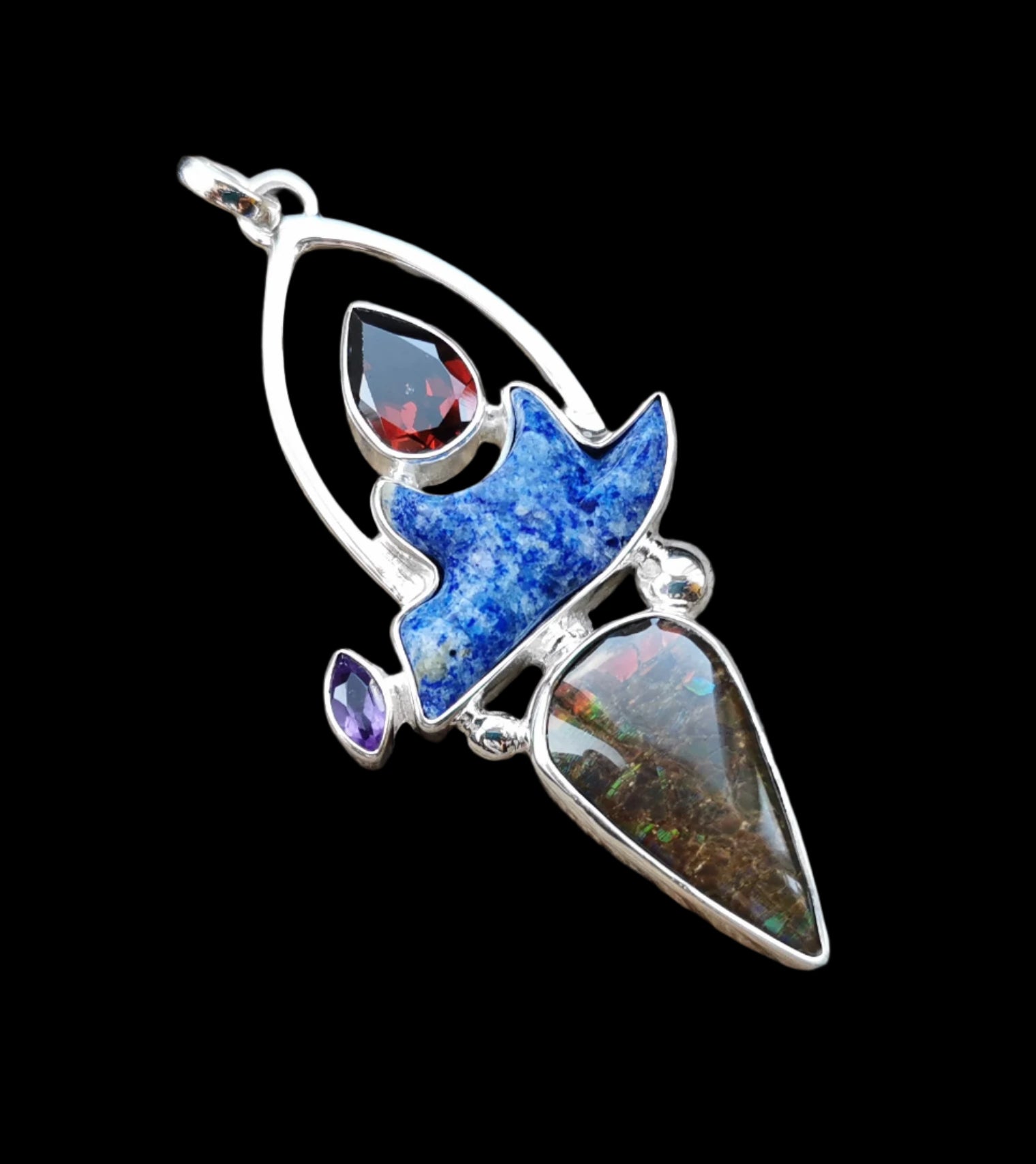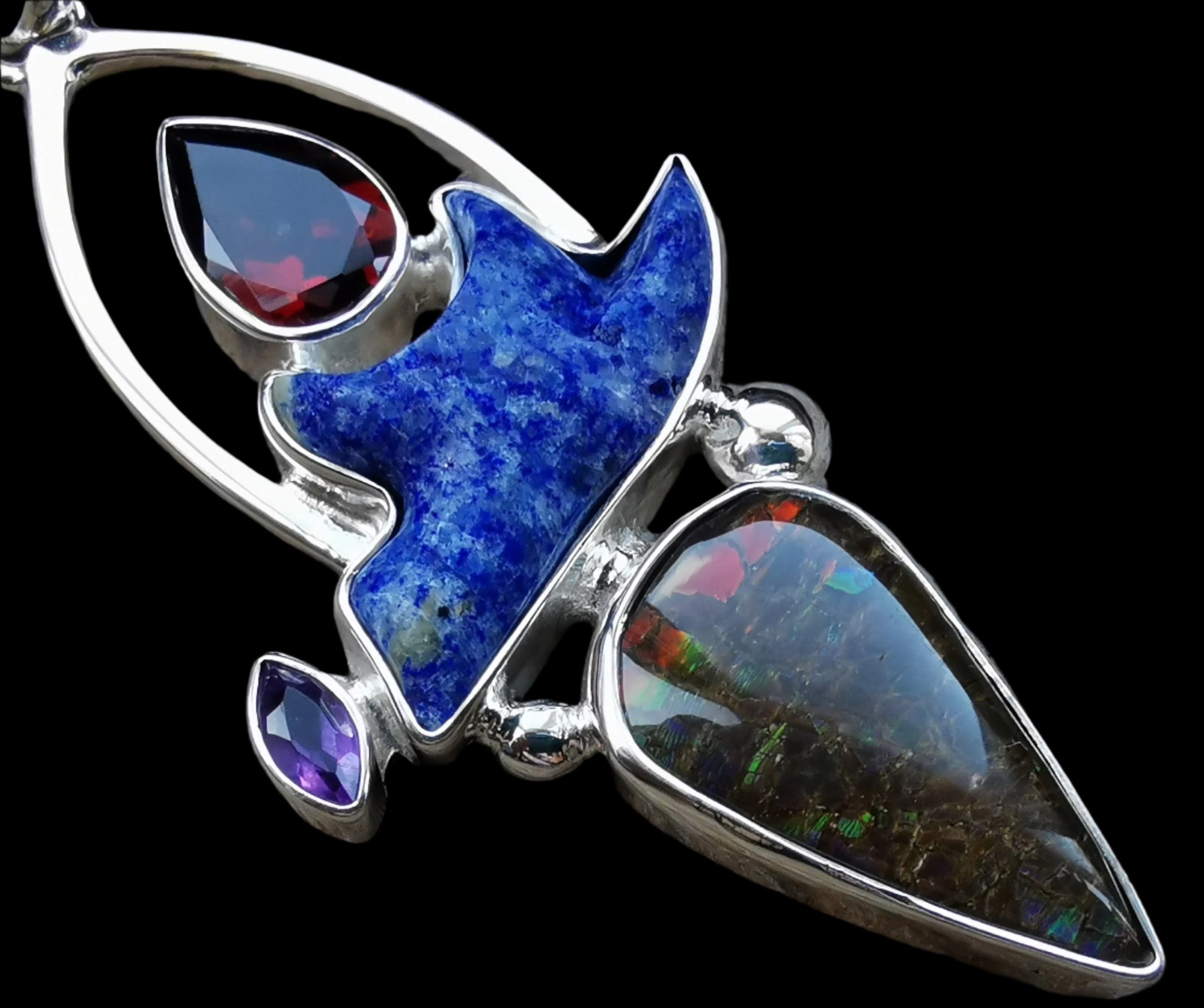Portal Glastonbury
Ref.PD1058
Ref.PD1058
Couldn't load pickup availability
Ref.PD1058 - Silver pendant with ammonite fossil, garnet, lapis lazuli, and amethyst gems.
This pendant symbolises a fire offering [light].
Fire, as a primal and transformative element, carries profound symbolic significance across cultures, philosophies, art, literature, and psychology. Its dual nature—both creative and destructive—makes it a powerful metaphor for a wide range of human experiences and concepts.
1. Transformation and Renewal
Core Symbolism: Fire’s ability to consume matter and convert it into energy, ash, or heat symbolizes transformation and renewal. It represents the potential for profound change, rebirth, or new beginnings emerging from destruction.
Cultural Contexts:
In Indigenous practices, such as controlled burns by Native American or Aboriginal Australian communities, fire clears old vegetation to promote fertile soil, symbolizing ecological and cultural renewal through cyclical processes.
In alchemy, fire is a catalyst for transmutation, representing the refinement of raw materials—or the self—into a purer, more valuable form, embodying personal growth or intellectual evolution.
In philosophical traditions like Stoicism, fire metaphorically “burns away” distractions or excesses, symbolizing clarity and self-discipline.
Examples:
The phoenix, a mythical bird reborn from its ashes, is a universal symbol of fire’s transformative power, representing resilience and the ability to rise anew after loss or failure.
In literature, fire often marks pivotal change, such as in Jane Eyre, where the burning of Thornfield Hall symbolizes the destruction of past burdens, enabling new beginnings.
2. Passion and Vitality
Core Symbolism: Fire’s intense heat and radiant light symbolize passion, vitality, and creative energy, evoking the spark of inspiration, desire, or emotional intensity.
Cultural Contexts:
In Romanticism, fire is a frequent motif for artistic and emotional fervor, as seen in William Blake’s fiery imagery (e.g., “The Tyger”), which conveys revolutionary zeal and creative power.
In psychology, fire in dreams or symbolism often represents strong emotions—love, anger, or ambition—driving personal motivation or inner conflict.
In Eastern philosophies like Taoism, fire’s dynamic energy aligns with the concept of qi, symbolizing life force and the flow of vitality.
Examples:
The phrase “a fire in the belly” captures ambition, determination, or intense drive, linking fire to inner motivation.
In modern culture, “igniting a spark” refers to inspiring creativity or passion, as in starting a movement or artistic project.
3. Destruction and Danger
Core Symbolism: Fire’s capacity to consume and devastate symbolizes destruction, chaos, or uncontrolled power, highlighting the risks of unchecked forces or emotions.
Cultural Contexts:
In literature, fire often represents catastrophic loss or oppression. In Ray Bradbury’s Fahrenheit 451, fire is used to burn books, symbolizing censorship, ignorance, and the destruction of knowledge.
In ecological narratives, wildfires symbolize nature’s raw power and humanity’s vulnerability, reflecting the consequences of environmental neglect or imbalance.
In folklore, fire’s destructive potential is a cautionary tale, as in stories where unchecked flames consume villages, symbolizing hubris or recklessness.
Examples:
The phrase “playing with fire” warns of risky behavior, emphasizing fire’s dangerous unpredictability.
In film, fire often foreshadows conflict, such as burning cities in dystopian movies, symbolizing societal collapse or upheaval.
4. Knowledge and Illumination
Core Symbolism: Fire’s light pierces darkness, symbolizing knowledge, truth, and enlightenment, as it illuminates both physically and metaphorically.
Cultural Contexts:
In Western philosophy, fire is linked to intellectual discovery, as in the Enlightenment era’s emphasis on reason as a “light” to dispel ignorance.
In ancient practices, fire was central to human survival (e.g., cooking, warmth), symbolizing humanity’s mastery of knowledge and innovation.
In psychoanalysis, fire may represent insight, with the “spark” of understanding breaking through mental fog.
Examples:
The Promethean myth (without divine framing) portrays fire as a gift of knowledge, enabling human progress and creativity, though at a cost.
The phrase “light a fire under someone” implies sparking motivation or awareness, tying fire to intellectual or emotional awakening.
5. Purification and Cleansing
Core Symbolism: Fire’s ability to burn away impurities symbolizes purification, cleansing, and the removal of unwanted elements, whether physical, emotional, or symbolic.
Cultural Contexts:
In ritual practices, bonfires or ceremonial fires (e.g., in Indigenous or secular traditions) burn away negativity, symbolizing emotional or communal renewal, as seen in solstice celebrations.
In literature, fire often purifies by eliminating corruption, such as in Lord of the Flies, where fire destroys the island’s chaos, though with tragic consequences.
In psychology, fire can symbolize emotional catharsis, burning away anger or trauma to achieve clarity.
Examples:
Burning old letters or objects in personal rituals symbolizes letting go of past burdens, aligning with fire’s cleansing role.
In cultural festivals like Burning Man, fire represents communal release and transformation through shared creative expression.
6. Energy and Power
Core Symbolism: Fire’s raw, uncontainable energy symbolizes power, strength, and force, both constructive and destructive.
Cultural Contexts:
In industrial history, fire powered the Industrial Revolution (e.g., steam engines), symbolizing human ingenuity and societal transformation.
In martial arts or performance arts (e.g., fire dancing), fire represents mastery and control, showcasing human skill over a volatile force.
In political symbolism, fire often denotes revolution or uprising, as in “fanning the flames” of social change.
Examples:
The Olympic flame symbolizes human achievement and unity, its continuous burning reflecting enduring strength.
In protest imagery, fire (e.g., burning flags) conveys intense resistance or transformative power.
7. Ambiguity and Duality
Core Symbolism: Fire’s dual nature—nurturing yet dangerous—symbolizes ambiguity, duality, and the balance between creation and destruction.
Cultural Contexts:
In existential philosophy, fire reflects life’s paradoxes, simultaneously sustaining (e.g., warmth) and threatening (e.g., burns), mirroring human struggles with meaning.
In art, fire’s flickering forms evoke complexity, as seen in Impressionist paintings where flames blur boundaries between light and chaos.
In modern culture, fire’s duality is captured in idioms like “a double-edged sword,” highlighting its potential for both harm and benefit.
Examples:
In Game of Thrones, fire is both a weapon (wildfire) and a tool for survival, embodying its contradictory roles.
The act of “burning bridges” symbolizes irreversible choices, reflecting fire’s capacity to both sever and liberate.
Practical and Cultural Contexts
Art and Literature: Fire is a versatile symbol in creative works. Baroque paintings use flames for dramatic intensity, while modernist works (e.g., T.S. Eliot’s The Waste Land) employ fire to convey desolation or purification. In cinema, fire often heightens emotional stakes, from romantic hearths to apocalyptic blazes.
Cultural Practices: Secular fire rituals, like bonfires at summer solstice or New Year’s celebrations, symbolize community, renewal, and shared energy, uniting people through spectacle.
Modern Culture: Fire inspires metaphors in technology (e.g., “firewall” for protection) and music (e.g., Alicia Keys’ “Girl on Fire,” symbolizing empowerment). In sports, “being on fire” denotes peak performance.
Psychological Symbolism: In therapy or dream analysis, fire may represent repressed emotions, transformation, or the need for release, with its intensity reflecting inner turmoil or passion.
Environmental Symbolism: In ecological discourse, fire symbolizes nature’s cycles—destructive wildfires clear forests, enabling regrowth, reflecting resilience and adaptation.
Variations Across Cultures
Western Traditions: Fire often symbolizes emotional intensity or intellectual light, as in Romantic poetry’s fiery passion or Enlightenment’s “spark” of reason.
Eastern Traditions: In Chinese philosophy, fire is one of the five elements, symbolizing energy, warmth, and transformation, balanced with other forces in the cycle of life.
Indigenous Perspectives: Fire is a tool and symbol of survival, used in storytelling (e.g., around campfires) to pass down knowledge and foster community.
African Traditions: Fire in oral traditions often represents communal strength, with hearths symbolizing family unity and shared resilience.
Conclusion
Fire’s symbolic significance spans transformation, passion, destruction, knowledge, purification, power, and duality, capturing the complexity of human and natural experiences. Its ability to create and destroy makes it a universal metaphor for change, energy, and ambiguity. From the phoenix’s rebirth to the spark of inspiration, fire resonates across cultures, art, and psychology, embodying both peril and potential. Its flickering presence in stories, rituals, and modern metaphors underscores its enduring role as a symbol of life’s dynamic forces.
Size: 62mm/2.44in approx.




